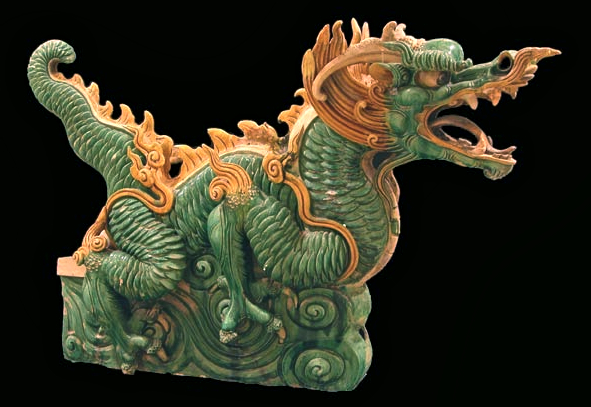

Title: Ancient Asian Chinese Ming Glazed Terracotta Architectural Dragon
Shipping: $29.00
Artist: N/A
Period: Unassigned
History: N/A
Origin: N/A
Condition: Museum Quality
Item Date: 1368 AD to 1644 AD
Item ID: 6396
Ming Glazed Terracotta Architectural Sculpture of a Dragon. Origin: China Circa: 1368 AD to 1644 AD Dimensions: 27.5" (69.9cm) high x 40.25" (102.2cm) depth Collection: Chinese Medium: Glazed Terracotta. Upon leading a victorious rebellion against the foreign Mongul rulers of the Yuan Dynasty, a peasant named Zhu Yuanzhang seized control of China and founded the Ming Dynasty in 1368. As emperor, he founded his capital at Nanjing and adopted the name Hongwu as his reign title. Hongwu, literally meaning “vast military,” reflects the increased prestige of the army during the Ming Dynasty. Due to the very realistic threat still posed by the Mongols, Hongwu realized that a strong military was essential to Chinese prosperity. Thus, the orthodox Confucian view that the military was an inferior class to be ruled over by an elite class of scholars was reconsidered. During the Ming Dynasty, China proper was reunited after centuries of foreign incursion and occupation. Ming troops controlled Manchuria, and the Korean Joseon Dynasty respected the authority of the Ming rulers, at least nominally. Like the founders of the Han Dynasty (206 B.C.- 220 A.D.), Hongwu was extremely suspicious of the educated courtiers that advised him and, fearful that they might attempt to overthrow him, he successfully consolidated control of all aspect of government. The strict authoritarian control Hongwu wielded over the affairs of the country was due in part to the centralized system of government he inherited from the Monguls and largely kept intact. However, Hongwu replaced the Mongul bureaucrats who had ruled the country for nearly a century with native Chinese administrators. He also reinstituted the Confucian examination system that tested would-be civic officials on their knowledge of literature and philosophy. Unlike the Song Dynasty (960-1279 A.D.), which received most of its taxes from mercantile commerce, the Ming economy was based primarily on agriculture, reflecting both the peasant roots of its founder as well as the Confucian belief that trade was ignoble and parasitic. Culturally, the greatest innovation of the Ming Dynasty was the introduction of the novel. Developed from the folk tales of traditional storytellers, these works were transcribed in the everyday vernacular language of the people. Advances in printmaking and the increasing population of urban dwellers largely contributed to the success of these books. Architecturally, the most famous monument of the Ming Dynasty is surely the complex of temples and palaces known as the Forbidden City that was constructed in Beijing after the third ruler of the Ming Dynasty, Emperor Yongle, moved the capital there. Today, the Forbidded Palace remains one of the hallmarks of traditional Chinese architecture and is one of the most popular tourist destinations in the vast nation. Glazed sculptural tile are today considered one of the hallmarks of classical Chinese architecture. However, despite their popularity in modern times, they were relatively scarce until after the end of the T’ang Dynasty. Even then, during the Song and Yuan Dynasties, they were still infrequently used. It was not until the rise of the Ming Dynasty that glazed sculptural tiles became a popular decorative devise extensively employed in temples, altars, imperial palaces, and gardens. Beijing became the center of glazed architectural tile production during the Ming period, and colorfully decorated pagodas began to sprout up around this region. Eaves and entryways were decorated with vibrant sculptures that served both decorative and sometimes religious purposes. On temples and palaces, representations of mounted warriors and snarling dragons were meant to ward off evildoers, of both the physical and spiritual kind. Judging from the shape of the base of this imposing dragon tile, it is likely that it once rested along the eaves of a roof or on the top a wall surrounding the grounds of a Ming Dynasty temple or palace. As an architectural ornament, this sculpture is a masterpiece. Surely the building that this work once adorned must have been quite spectacular. The dragon sits upon a swirling cloud, head held upwards, mouth ajar, as if poised to release a breath of fire. Spiky horns decorate the dragon’s head and spine that themselves appear like miniature flames. When we imagine the entire temple structure covered in such tiles, from the walls to the roof, the glory of Ming Dynasty China becomes apparent.
Link: http://en.wikipedia.org/wiki/Dragon
A dragon is a legendary creature, typically with serpentine or reptilian traits, that features in the myths of many cultures. There are two distinct cultural traditions of dragons: the European dragon, derived from European folk traditions and ultimately related to Greek and Middle Eastern mythologies, and the Chinese dragon, with counterparts in Japan (namely the Japanese dragon), Korea and other East Asian countries.
The two traditions may have evolved separately, but have influenced each other to a certain extent, particularly with the cross-cultural contact of recent centuries. The English word "dragon" derives from Greek, "dragon, serpent of huge size, water-snake".
A dragon is a mythological representation of a reptile. In antiquity, dragons were mostly envisaged as serpents, but since the Middle Ages, it has become common to depict them with legs, resembling a lizard.
Dragons are usually shown in modern times with a body like a huge lizard, or a snake with two pairs of lizard-type legs, and able to emit fire from their mouths.